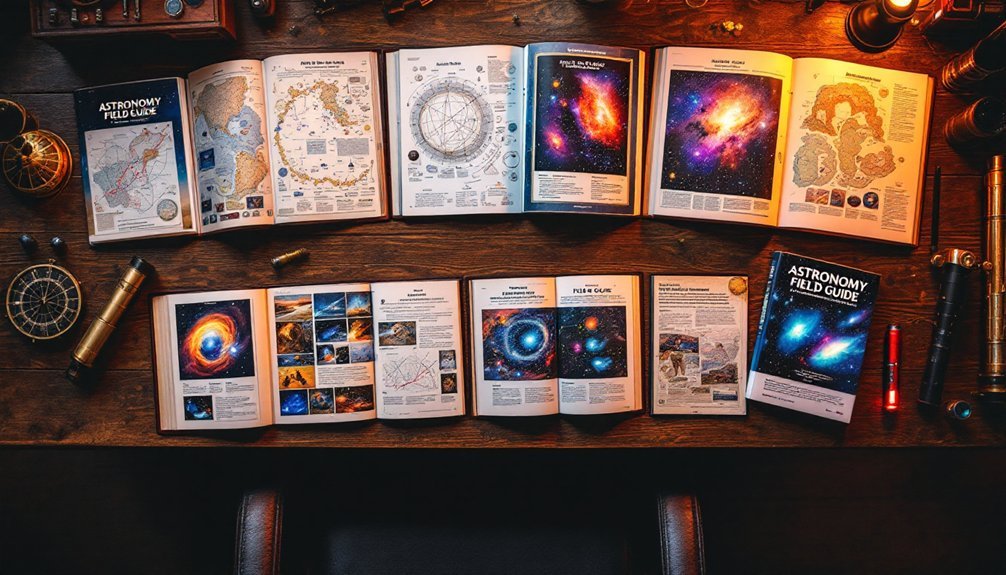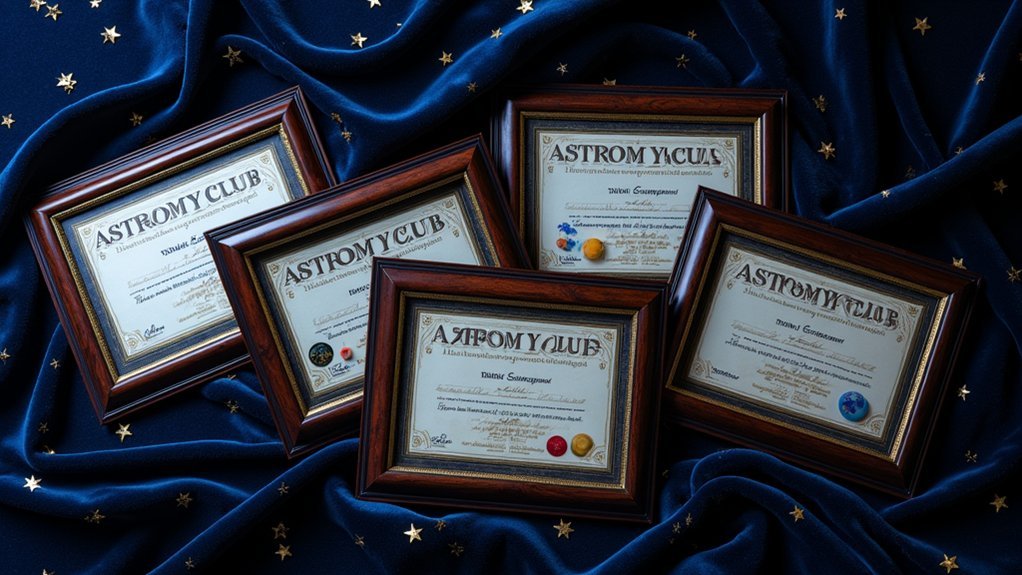You'll find that exploring deep-sky objects becomes much more rewarding when you've got the right guide by your side. As 2025 brings enhanced telescope technology and clearer night skies to amateur astronomers, choosing the perfect companion for your stargazing adventures has never been more important. Whether you're tracking down elusive nebulae or hunting for distant galaxies, these seven authoritative guides can transform your nights under the stars from random viewing to purposeful discovery.
Observers Sky Atlas: The 500 Best Deep-Sky Objects With Charts and Images
The Observers Sky Atlas stands as a cornerstone resource for both beginners and seasoned astronomers who want to explore deep-sky objects. In its fourth edition by Erich Karkoshka, you'll find extensive details on 500 celestial wonders, complete with coordinates, constellation maps, and visibility indicators.
What sets this atlas apart is its practical features: a color scheme optimized for red light viewing, a unique domino system for visibility, and close-up images showing how objects appear through different devices. Thanks to data from the Hipparchos and Gaia satellites, you'll get precise stellar distances. The atlas's affordability and user-friendly format make it an invaluable tool for planning your stargazing sessions.
Best For: Amateur astronomers and stargazers of all skill levels seeking a comprehensive, user-friendly guide to observing deep-sky objects with detailed charts and practical viewing information.
Pros:
- Optimized color scheme for red light viewing and practical domino system for tracking object visibility
- Includes updated stellar distances from modern satellite data (Hipparchos and Gaia)
- Comprehensive yet affordable guide with detailed charts, coordinates, and images showing how objects appear through different devices
Cons:
- Fourth edition format may take time to adapt to for users familiar with previous editions
- May contain more detail than casual stargazers need
- Physical size might be challenging to handle while observing in the field
Deep-Sky Companions: The Messier Objects
Written by James O'Meara, "Deep-Sky Companions: The Messier Objects" stands out as an essential guide for amateur astronomers who want to explore Charles Messier's famous catalog of 110 deep-sky objects.
You'll find detailed 3-4 page entries for each celestial wonder, complete with technical data, amateur photos, and hand-drawn sketches. O'Meara's engaging writing style makes complex astronomical concepts accessible, while the included finder charts help you locate targets. The book's particularly useful for understanding celestial coordinates and identifying various deep-sky formations.
While excellent overall, you'll need to supplement the Second Edition with a complete star chart, as it's not included like in the First Edition.
Best For: Amateur astronomers and stargazers seeking detailed guidance on observing and understanding Messier objects, particularly those who want in-depth descriptions and practical observation tips.
Pros:
- Comprehensive 3-4 page descriptions for each of the 110 Messier objects
- Clear, engaging writing style that makes complex astronomical concepts accessible
- Includes detailed finder charts and technical data for each object
Cons:
- Second Edition lacks the complete star chart found in First Edition
- Contains only monochrome images
- Finder charts alone may not be sufficient for locating objects without additional star maps
Deep Sky Objects: The Best And Brightest from Four Decades of Comet Chasing
Amateur astronomers seeking both practical guidance and engaging storytelling will find David Levy's "Deep Sky Objects: The Best And Brightest" an invaluable companion. As one of history's most successful comet discoverers, Levy shares his expertise through a unique blend of personal anecdotes and practical advice.
You'll discover celestial objects organized by their distance from Earth, complete with essential details like positions, magnitudes, and ideal viewing times. What makes this guide stand out is Levy's ability to make deep-sky observation accessible, even for city-based stargazers. His carefully curated lists help you avoid misidentifying objects as comets, while his enthusiastic storytelling transforms technical content into an engaging astronomical journey.
Best For: Amateur astronomers and stargazing enthusiasts who want a blend of practical observation guidance and personal storytelling from an experienced comet hunter.
Pros:
- Combines technical instruction with engaging personal anecdotes from the author's four decades of experience
- Provides comprehensive details about celestial objects, including positions, magnitudes, and optimal viewing times
- Includes helpful lists to prevent misidentification of objects during comet hunting
Cons:
- May be too narrative-focused for readers seeking purely technical information
- English major background of author means some technical explanations might not be as detailed as those from academic astronomers
- Organization by distance from Earth might not be the most practical arrangement for all observing purposes
Deep Sky Observers Guide
Veteran Scottish astronomer Neil Bone's extensive guide serves as an invaluable companion for stargazers using medium-sized telescopes up to 6 inches in diameter. You'll find detailed reviews of deep sky objects beyond the Messier list, including nebulae, globular clusters, open clusters, multiple stars, and galaxies.
The guide's strength lies in its practical organization, featuring observing tips, equipment recommendations, and cross-referenced sky maps. You'll appreciate the color photos from observatories and Hubble, alongside realistic eyepiece views showing what you'll actually see through your telescope. While the included maps might be basic, you'll find this thorough guide especially useful if you're using an 80mm short tube refractor.
Best For: Amateur astronomers using medium-sized telescopes (up to 6 inches) who want a comprehensive guide to observing deep sky objects beyond the Messier list.
Pros:
- Extensive practical guidance with detailed object reviews and observing tips
- Well-organized content with cross-referenced sky maps and multiple categorization methods
- Includes both professional observatory photos and realistic eyepiece views
Cons:
- Basic maps may be inadequate for some users
- Limited to objects visible through medium-sized telescopes
- May contain more information than needed for casual observers
Deep-Sky Wonders: A Tour of the Universe with Sky and Telescopes Sue French
The legacy of Sky & Telescope Magazine's "Deep-Sky Wonders" column comes alive in Sue French's extensive guide, making it an invaluable resource for stargazers who want to explore beyond the basic catalogs.
You'll find the content conveniently arranged by month, with eight to nine columns per section to help you plan your observations. The 300+ page hardbound book features detailed star charts, coordinates, and magnitude information. French's thorough guidance helps you locate objects using scopes of various sizes, from small refractors to larger apertures.
Whether you're hunting popular Messier objects or challenging Sharpless and Barnard catalog items, you'll appreciate French's lively descriptions and practical observing tips.
Best For: Amateur astronomers and stargazers of all skill levels seeking a comprehensive, month-by-month guide to exploring deep-sky objects beyond the basic catalogs.
Pros:
- Organized by month for convenient seasonal observing planning
- Includes detailed star charts, coordinates, and practical viewing instructions for objects visible through various telescope sizes
- Combines both popular and lesser-known celestial objects with thorough descriptions and observing tips
Cons:
- Some objects require large aperture telescopes and dark skies to observe effectively
- Additional star atlases or software may be needed for beginners to locate targets
- Contains some minor errors noted by readers
Sky Gazing: A Guide to The Moon, Stars, and Planets
Looking to introduce young minds to the wonders of astronomy? "Sky Gazing" offers a perfect entry point for 8-10 year olds, though you'll find it engaging for all ages. This hardcover guide features a glow-in-the-dark cover and stunning visuals that bring astronomical concepts to life.
You'll appreciate how the book breaks down complex topics into digestible chunks, with Star Dude, a friendly cartoon character, providing fun definitions along the way. The hands-on activities, like creating red flashlights and pinhole projectors, transform passive learning into active exploration. It's an ideal resource for both homeschooling and classroom settings, making astronomy accessible and exciting for young stargazers.
Best For: Young learners aged 8-10 and their families who want an accessible, visually engaging introduction to astronomy with hands-on activities.
Pros:
- Beautiful visual presentation with colorful illustrations, photos, and a glow-in-the-dark cover that captures young readers' attention
- Complex astronomical concepts broken down into easily digestible chunks with fun, cartoon-guided explanations
- Includes practical hands-on activities and crafts that make learning interactive and memorable
Cons:
- Age range might be too limited for older students seeking more advanced astronomical information
- Some hands-on activities may require adult supervision and additional materials
- Might be too basic for children already well-versed in astronomy
The Deep-sky Imaging Primer
Serious amateur astronomers seeking thorough guidance on deep-sky astrophotography will find Charles Bracken's "Deep-sky Imaging Primer" invaluable. This 202-page guide breaks down complex imaging concepts into three digestible sections: electronic imaging fundamentals, image acquisition, and processing methods.
You'll learn essential signal-to-noise principles before diving into both CCD and DSLR techniques. The book's strength lies in its detailed Photoshop processing tutorials, featuring real-world examples like the Witch's Broom and Rosette Nebulae. While it doesn't focus on specific equipment recommendations, you'll gain timeless knowledge about image calibration, noise reduction, and post-processing that applies to any setup.
Best For: Amateur astronomers and astrophotography enthusiasts who want to understand the technical foundations of deep-sky imaging and improve their post-processing skills.
Pros:
- Comprehensive coverage of fundamental concepts like signal-to-noise ratio and image calibration
- Clear, practical tutorials for both CCD and DSLR processing using Photoshop
- Timeless technical information that remains relevant regardless of equipment choices
Cons:
- Lacks specific equipment recommendations for those seeking buying guidance
- Focuses primarily on Photoshop CS3, which may feel dated for users of newer software
- Dense technical content may be challenging for complete beginners to grasp initially
Factors to Consider When Choosing Deep Sky Object Guides
When you're selecting a deep sky object guide, you'll need to evaluate several key factors that match your needs and capabilities. Your skill level, telescope specifications, and the guide's image quality will determine how effectively you can locate and observe celestial objects. The guide's organization method and star-hopping instructions should align with your preferred approach to traversing the night sky.
Skill Level and Experience
Since amateur astronomers progress through various stages of expertise, choosing the right deep sky object guide requires careful consideration of your current skill level and experience. If you're a beginner, look for guides with simplified concepts, basic observational techniques, and clear explanations of astronomical terms in everyday language. These guides often feature colorful illustrations and organize content by seasonal visibility.
As your skills advance, you'll want guides that offer more detailed information about stellar distances, specialized observational methods, and thorough object databases. Expert-level resources typically include technical terminology, high-quality star charts, and organize content by object type rather than season. They'll provide intricate details that help you locate and observe more challenging targets. Match your guide's complexity to your current abilities to maximize your learning and viewing experience.
Observing Equipment Requirements
Matching your deep sky object guide to your available equipment guarantees you'll get the most value from your astronomical observations. When selecting a guide, consider your telescope's aperture size, as it determines which objects you'll realistically be able to view. A guide featuring primarily faint galaxies won't serve you well if you're using a small telescope.
Your mount type, filter collection, and eyepiece selection should also influence your guide choice. If you're using a basic mount without tracking capabilities, you'll want a guide that focuses on objects suitable for quick observations. Don't forget to factor in your local viewing conditions – if you're observing from a light-polluted area, look for guides that highlight brighter objects or provide specific recommendations for urban astronomers.
Image Quality and Charts
Clear, well-produced images and charts serve as the backbone of any effective deep sky object guide. When evaluating a guide's visual content, you'll want to look for high-resolution photographs and detailed star maps that accurately represent what you'll see through your telescope.
The best guides feature extensive charts with precise celestial coordinates, magnitude data, and scale indicators. You'll find color illustrations particularly helpful, as they enhance your understanding of each object's characteristics and make learning more engaging. Pay close attention to the quality of close-up images, as they'll help you set realistic expectations for your observations.
Don't settle for guides with poor image resolution or unclear charts – they can lead to frustrating misidentifications in the field. Sharp, detailed visuals will greatly improve your success rate in locating and identifying deep sky objects.
Content Organization Methods
The organization of content within deep sky object guides plays an essential role in your observing success. You'll find the most effective guides categorize objects by type, making it easy to locate specific nebulae, galaxies, or star clusters you're interested in viewing.
Look for guides that offer seasonal or monthly sections to help you plan your observations throughout the year. You'll also benefit from thorough cross-referencing tables that sort objects by criteria like magnitude and constellation. These organizational features let you quickly identify suitable targets for your equipment and viewing conditions.
When evaluating guides, check for clear finder charts and celestial coordinates that help you locate objects precisely. The best guides combine these practical organizational elements with visual aids that show you what to expect through your telescope.
Star Location Guidance
Successful star location guidance relies on three fundamental elements in deep sky object guides: precise celestial coordinates, detailed finder charts, and seasonal timing recommendations.
Look for guides that provide Right Ascension and Declination coordinates to pinpoint exact object positions. You'll want clear, well-drawn finder charts that show surrounding star patterns, making it easier to star-hop to your target. Pay attention to guides that include domino systems or visibility indicators – these tools help you determine if an object is observable during your planned viewing session.
Choose guides that specify ideal viewing seasons and explain which telescope size you'll need for different deep-sky objects. This combination of coordinate precision, visual aids, and practical observing guidance will greatly enhance your success rate in locating celestial treasures.
Frequently Asked Questions
What Equipment Do I Need to Start Observing Deep Sky Objects?
You'll need a telescope (6" aperture or larger), a dark sky location, star charts or astronomy apps, red flashlight, and eyepieces. A Dobsonian mount is great for beginners exploring deep sky objects.
How Dark Does the Sky Need to Be for Viewing?
You'll need a dark sky with minimal light pollution – ideally away from cities. The darker the better, but you should at least be able to see the Milky Way clearly for good DSO viewing.
Can Deep Sky Objects Be Photographed With a Smartphone?
You can photograph some deep sky objects with your smartphone, but you'll need special adapters to mount it to a telescope and apps for long exposures. Results won't match dedicated astronomy cameras.
What's the Best Time of Year to Observe Specific Objects?
You'll find different deep sky objects are best viewed in specific seasons. For example, you can spot the Orion Nebula in winter, while the Andromeda Galaxy's best viewing comes during autumn nights.
How Long Does It Take to Learn Deep Sky Object Identification?
You'll need about 3-6 months to learn basic DSO identification if you're observing regularly. With good star charts and practice twice weekly, you'll start recognizing common objects like the Orion Nebula naturally.
In Summary
Whether you're a novice or experienced stargazer, these seven deep-sky object guides will enhance your astronomical journey in 2025. You'll find detailed charts, stunning visuals, and expert tips to help you navigate the cosmos. Choose the guide that matches your skill level and interests, and don't forget to take into account factors like seasonal viewing patterns and your telescope's capabilities. The universe awaits your exploration.





Leave a Reply